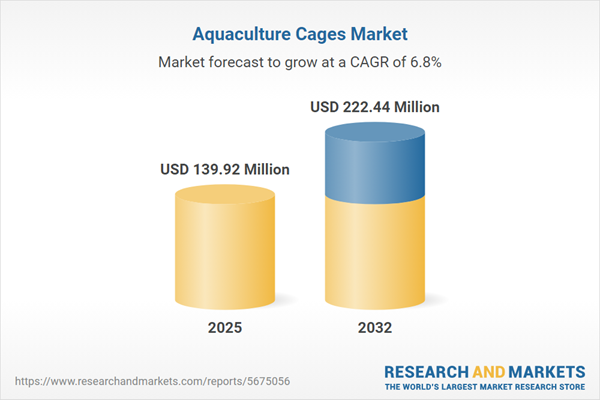Speak directly to the analyst to clarify any post sales queries you may have.
The aquaculture cages market is undergoing significant transformation as senior executives navigate rising environmental, regulatory, and operational demands. Aligning sustainability, supply chain efficiency, and advanced technology adoption has become central to strategic planning and investment.
Market Snapshot: Growth Trajectory in the Aquaculture Cages Market
The global aquaculture cages market is set for continued expansion, maintaining a solid compound annual growth rate (CAGR) projected through 2032.
Growth is driven by the urgent need for secure protein supply, increased regulatory engagement, and the acceleration of environmentally responsible production approaches. Leading firms are deploying advanced cage technologies tailored to regional oversight and varied species requirements. The integration of extensive monitoring systems and the formation of multi-level value chain alliances are enabling operational efficiency and promoting coordinated supply on a global scale. This landscape is fostering continuous innovation that keeps pace with evolving compliance frameworks and shifting stakeholder expectations.Scope & Segmentation
- Farm Type: Targets commercial-scale operations, ornamental and display species facilities, and research-focused farms that advance species adaptation and technology integration.
- System Type: Includes fixed, floating, and submersible cage systems adaptable to both protected inland waters and challenging offshore environments.
- Species Cultured: Encompasses fin fish such as salmon, tilapia, and trout; a broad portfolio of shellfish like mussels and oysters; and primary shrimp varieties, each requiring tailored operational and management protocols.
- Cage Type: Offers freshwater, inshore, and offshore cage models, facilitating regulatory compliance across diverse jurisdictions and supporting varied sustainable aquaculture practices.
- Cage Material: Highlights aluminum, polyethylene, and steel, recognized for regulatory acceptance, operational longevity, and compliance with sustainability benchmarks in the aquaculture cages market.
- Farm Scale: Spans solutions for industrial-scale enterprises and community-oriented operations, enhancing sector adoption and overall growth.
- Regions: Covers key dynamics in the Americas (United States, Canada, Chile, Brazil), Europe, Middle East & Africa (including France, Russia, South Africa, Saudi Arabia), and Asia-Pacific (China, India, Japan, Australia), accounting for local regulatory, supply, and operational distinctions that influence strategy.
- Companies Analyzed: Examines innovation from AKVA Group ASA, Pentair Aquatic Eco-Systems, Lindéngruppen AB, and Ocean Farm Technologies, providing insights into technological leadership trends shaping global competition.
Aquaculture Cages Market: Key Takeaways
- Material science developments and sensor integration are boosting the structural resilience and reliability of modern cage systems, aligning with tightening environmental standards.
- Adoption of data-centric management tools and connected monitoring technologies enables responsive operations and improved risk management for ecosystem health and compliance.
- Procurement priorities focus on sustainable, certified materials that support environmental objectives while enhancing organizational reputation and marketability.
- Collaboration spanning technology firms, genetics innovators, and feed suppliers is elevating stock health through integrated solutions, ensuring greater productivity across farming cycles.
- Scalable, modular engineering approaches are allowing enterprises of every size to adapt more quickly within evolving regulatory settings and capitalize on emerging opportunities.
Impact of U.S. Tariff Adjustments
Recent U.S. tariff adjustments on steel and polymer feedstocks have prompted manufacturers and operators to reassess sourcing. Many are strengthening domestic supplier ties and pursuing new joint ventures to secure supply chains and accelerate innovation. Remaining agile as trade dynamics shift is essential for preserving a competitive edge in the international market.
Methodology & Data Sources
This research combines comprehensive secondary data with direct input from cage system engineers, marine biologists, and compliance experts. Findings have been verified with in-person site assessments and targeted stakeholder surveys, ensuring results are relevant and actionable for market participants.
Why This Report Matters
- Provides a foundation for benchmarking operational practices, aligning digital technology adoption, and optimizing compliance strategy as regulatory demands evolve.
- Clarifies how sustainability requirements, digitalization, and regional supply alliances drive investment and inform risk management decisions within aquaculture cages operations.
- Supports informed planning for market entry and regional expansion, enabling organizations to build resilience and adaptability amid industry changes.
Conclusion
Strategic adaptation to regulatory change, continuous product development, and robust supply network partnerships are crucial for success in the aquaculture cages market. Prioritizing these factors allows organizations to capture sustained value as industry standards advance.
Additional Product Information:
- Purchase of this report includes 1 year online access with quarterly updates.
- This report can be updated on request. Please contact our Customer Experience team using the Ask a Question widget on our website.
Table of Contents
3. Executive Summary
4. Market Overview
7. Cumulative Impact of Artificial Intelligence 2025
List of Figures
Samples

LOADING...
Companies Mentioned
The key companies profiled in this Aquaculture Cages market report include:- AKVA Group ASA
- Pentair Aquatic Eco-Systems, Inc.
- Lindéngruppen AB
- SubCtech GmbH & Co. KG
- Aquaculture of Texas Inc.
- SeaQure AB
- Sangir Plastics Pvt. Ltd.
- Aquatic Network
- Ocean Farm Technologies Ltd
Table Information
| Report Attribute | Details |
|---|---|
| No. of Pages | 196 |
| Published | October 2025 |
| Forecast Period | 2025 - 2032 |
| Estimated Market Value ( USD | $ 139.92 Million |
| Forecasted Market Value ( USD | $ 222.44 Million |
| Compound Annual Growth Rate | 6.8% |
| Regions Covered | Global |
| No. of Companies Mentioned | 10 |









